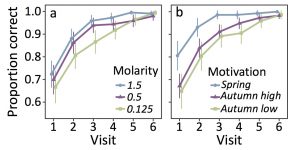Small differences in learning speed for different food qualities can drive efficient collective foraging in ant colonies
Preprint posted on 1 March 2018 http://dx.doi.org/10.1101/274209
Article now published in Behavioral Ecology and Sociobiology at http://dx.doi.org/10.1007/s00265-018-2583-6
Motivation and food quality can affect the learning speeds and persistence of individual ants when foraging. This effect could drive the choice of specific food sources by a colony without the need for communication between ants or pheromone trails.
Selected by James FosterCategories: animal behavior and cognition
The Story
An important part of life as a social insect is working together to make the best decisions for the colony. Food sources in the surrounding environment may differ in quality, and new ones can appear at any moment. The colony’s reproductive output is affected by its ability to collect nutrients, so it must choose wisely between the available food sources. Bees and ants can communicate to one another about newly discovered food sources using various methods: honeybees famously “dance” information about direction and distance, and some ants lead or even carry their sisters to the desired location. In this manuscript the authors propose means for a colony to choose profitable food sources based purely on individual learning rates, with the tendency of individuals to return to a food source set by motivating factors and food source quality, which in turn would result in efficient foraging at the colony level.
The Study
The authors investigated how learning rates of individual black garden ants are affected by season, motivation and food source quality. They gave individual ants the opportunity to visit a pair of food sources in a choice chamber, one of which provided a sugar solution and the other of which provided only water. Most ants learned quickly to choose the sugar, although when motivation and sugar concentration were low many ants gave up visiting the choice chamber. Crucially, ants learnt faster in spring, when the colony needs nutrients most. Ants were less persistent in autumn, and even less so when the starvation period before the experiment was reduced from four days to one; an effect that was amplified by reducing the sugar concentration of the food source. These effects are presented alongside a simulation, suggesting that the learning rates of individual ants could lead to the nest as a whole choosing either to forage from many low quality food sources, or to identify and forage from only a few high quality ones, depending on their nutritional requirements.

(http://www.animal-economics.com/)
Questions
How might even lower sucrose molarities affect learning and persistence rates? Are the ones used close to the threshold for what can be learnt?
Is it possible to manipulate the motivation of individual ants, perhaps physiologically? It would be interesting to know to what extent motivation is shared within the colony and how much it can vary between individuals (as the simulation suggests).
Posted on: 10 April 2018
Read preprintSign up to customise the site to your preferences and to receive alerts
Register hereAlso in the animal behavior and cognition category:
Experience-dependent plasticity of a highly specific olfactory circuit in Drosophila melanogaster
Behavioral screening of conserved RNA-binding proteins reveals CEY-1/YBX RNA-binding protein dysfunction leads to impairments in memory and cognition
Pervasive sublethal effects of agrochemicals as contributing factors to insect decline
preLists in the animal behavior and cognition category:
9th International Symposium on the Biology of Vertebrate Sex Determination
This preList contains preprints discussed during the 9th International Symposium on the Biology of Vertebrate Sex Determination. This conference was held in Kona, Hawaii from April 17th to 21st 2023.
| List by | Martin Estermann |
Bats
A list of preprints dealing with the ecology, evolution and behavior of bats
| List by | Baheerathan Murugavel |
FENS 2020
A collection of preprints presented during the virtual meeting of the Federation of European Neuroscience Societies (FENS) in 2020
| List by | Ana Dorrego-Rivas |











 (No Ratings Yet)
(No Ratings Yet)